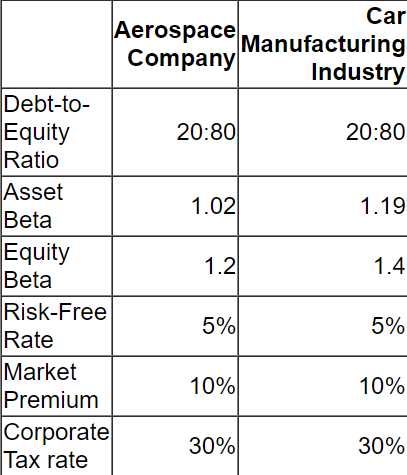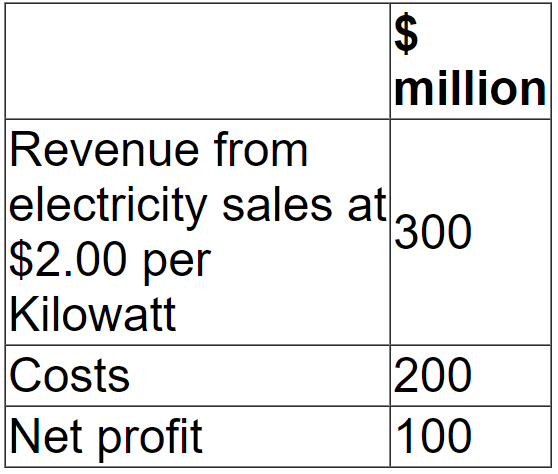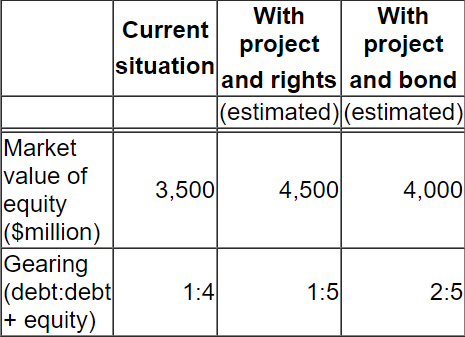CIMA F3 - Financial Strategy
An aerospace company is planning to diversify into car manufacturing.Â
Â
Relevant data:
  
What is the the cost of equity to be used in the WACC for the project appraisal?
Â
Give your answer in percentage, as a whole number.
Â
Company X is an established, unquoted company which provides IT advisory services.
The company's results and cashflows are growing steadily and it has few direct competitors due to the very specialised nature of it's business. Dividends are predictable and paid annually.
Company PÂ is looking to buy 30% of company X's equity shares.
Â
Which TWO of the following methods are likely to be considered most suitable valuation methods for valuing company P's investment in Company X?
A company is based in Country Y whose functional currency is Y$. It has an investment in Country Z whose functional currency is Z$.
This year the company expects to generate Z$ 10 million profit after tax.
Tax Regime:
   • Corporate income tax rate in country Y is 50%
   • Corporate income tax rate in country Z is 20%
   • Full double tax relief is available
Assume an exchange rate of Y$ 1 = Z$ 5.
Â
What is the expected profit after tax in Y$ if the Z$ profit is remitted to Country Y?
The table below shows the forecast for a company's next financial year:
 
Â
The forecast incorporates the following assumptions:
   • 25% of operating costs are variable
   • Debt finance comprises a $400 million fixed rate loan at 5%
   • Corporate income tax is paid at 25%
Â
The company plans to do the following next year from the forecast earnings on the assumption that earnings will be equivalent to free cash flow:Â
   • Pay a total dividend of $20 million
   • Invest $40 million in new projects
Â
What is the maximum % reduction in operating activity that could occur next year before the company's dividend and investment plans are affected?
Â
Give your answer to the nearest 0.1%.
Â
 Â
G purchased a put option that grants the right to cap the interest on a loan at 10.0%. Simultaneously, G sold a call option that grants the holder the benefits of any decrease if interest rates fall below 8.5%.
Which THREE possible explanations would be consistent with G's behavior?
A company generates and distributes electricity and gas to households and businesses.Â
Â
Forecast results for the next financial year are as follows:
  
The Industry Regulator has announced a new price cap of $1.50 per Kilowatt.Â
The company expects this to cause consumption to rise by 10% but costs would remained unaltered.Â
Â
The price cap is expected to cause the company's net profit to fall to:
A listed company has recently announced a profit warning.
Â
The company's share price fell 20% on the day of the announcement but had been fairly static in the weeks leading up to the announcement.
Â
Which form of efficient market is most likely to be indicated by this share price movement?
HHH Company has a fixed rate loan at 10.0%, but wishes to swap to variable. It can borrow at the risk-free rate +8%. The bank is currently quoting swap rates of 3.1% (bid) and 3.5% (ask). What net rate will HHH Company pay if it enters into the swap?
A company based in the USA has a substantial fixed rate borrowing at an interest rate of 3.5% and wishes to swap a part of this to a floating rate to take advantage of reducing interest rates Its bank has quoted swap rates of 3 4%-3 5% against 12-month USD risk-free rate.
What is the overall interest rate achieved by the company under this borrowing plus swap combination?
A listed company plans to raise $350 million to finance a major expansion programme.
The cash flow projections for the programme are subject to considerable variability.
Brief details of the programme have been public knowledge for a few weeks.
The directors are considering two financing options, either a rights issue at a 20% discount to current share price or a long term bond.
Â
The following data is relevant:
  
The company's share price has fallen by 5% over the past 3 months compared with a fall in the market of 3% over the same period.
The directors favour the bond option.
However, the Chief Accountant has provided arguments for a rights issue.
Â
Which TWO of the following arguments in favour of a right issue are correct?



